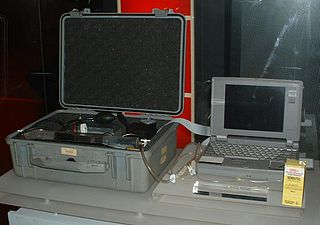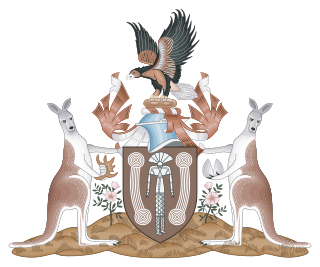
The Australian Capital Territory (ACT), known as the Federal Capital Territory (FCT) until 1938, is a federal territory of Australia. Canberra, the capital city of Australia, is located in this territory. It is located in southeastern Australian mainland as an enclave completely within the state of New South Wales. Founded after Federation as the seat of government for the new nation, the territory hosts the headquarters of all important institutions of the Australian Government.

The Country Liberal Party of the Northern Territory (CLP), commonly known as the Country Liberals, is a centre-right political party in Australia's Northern Territory. In local politics, it operates in a two-party system with the Australian Labor Party (ALP). It also contests federal elections as an affiliate of the Liberal Party of Australia and National Party of Australia, the two partners in the federal coalition.

Devolution is the statutory delegation of powers from the central government of a sovereign state to govern at a subnational level, such as a regional or local level. It is a form of administrative decentralization. Devolved territories have the power to make legislation relevant to the area, thus granting them a higher level of autonomy.
Electoral systems of the Australian states and territories are broadly similar to the electoral system used in federal elections in Australia.

The Rights of the Terminally Ill Act 1995 (NT) was a controversial law legalising euthanasia in the Northern Territory of Australia, which was passed by the territory's Parliament in 1995. The Act was passed by the Northern Territory Legislative Assembly on 25 May 1995 by a vote of 15 to 10, received the Administrator's assent on 16 June 1995, and entered into force on 1 July 1996. A year later, a repeal bill was brought before the Northern Territory Parliament in August 1996, but was defeated by 14 votes to 11.
The parliaments of the Australian states and territories are legislative bodies within the federal framework of the Commonwealth of Australia.

The Legislative Assembly of the Northern Territory is the unicameral legislature of the Northern Territory of Australia. The Legislative Assembly has 25 members, each elected in single-member electorates for four-year terms. The voting method for the Assembly is the full-preferential voting system, having previously been optional preferential voting. Elections are on the fourth Saturday in August of the fourth year after the previous election, but can be earlier in the event of a no confidence vote in the Government. The most recent election for the Legislative Assembly was the 2020 election held on 22 August 2020. The next election is scheduled for 24 August 2024.

The Legislative Assembly for the Australian Capital Territory is the unicameral legislature of the Australian Capital Territory (ACT). It sits in the Legislative Assembly Building on Civic Square, close to the centre of the city of Canberra.

The Parliament of New South Wales is a bicameral legislature in the Australian state of New South Wales (NSW), consisting of the New South Wales Legislative Assembly and the New South Wales Legislative Council. Each house is directly elected by the people of New South Wales at elections held approximately every four years. The Parliament derives its authority from the King of Australia, King Charles III, represented by the Governor of New South Wales, who chairs the Executive Council. The parliament shares law making powers with the Australian Federal Parliament. The New South Wales Parliament follows Westminster parliamentary traditions of dress, Green–Red chamber colours and protocols.

The Government of the Northern Territory of Australia, also referred to as the Northern Territory Government, is the Australian territorial democratic administrative authority of the Northern Territory. The Government of Northern Territory was formed in 1978 with the granting of self-government to the Territory. The Northern Territory is a territory of the Commonwealth of Australia, and the Constitution of Australia and Commonwealth law regulates its relationship with the Commonwealth.

The Australian Capital Territory (Self-Government) Act 1988 is an Act of the Parliament of Australia enacted on 6 December 1988, that establishes "a body politic under the Crown by the name of the Australian Capital Territory" and is the constitutional foundation of the Territory's government.
Elections to the 1989 Australian Capital Territory Legislative Assembly was held on Saturday, 4 March. This was the first direct election by voters in the Australian Capital Territory (ACT) for their power legislative body.

The states and territories of Australia are the first-level administrative divisions of the country. The states are self-governing polities that are partly sovereign, having ceded some sovereign rights to the federal government. They have their own constitutions, legislatures, executive governments, judiciaries and law enforcement agencies that administer and deliver most public policies and programs. Territories can be autonomous and administer local policies and programs much like the states in practice, but are still legally subordinate to the federal government.

The Government of the Australian Capital Territory, also referred to as the Australian Capital Territory Government or ACT Government, is the executive authority of the Australian Capital Territory, one of the territories of Australia. The leader of the party or coalition with the confidence of the Australian Capital Territory Legislative Assembly forms Government. Unlike the Australian States and the Northern Territory, the Australian Capital Territory Legislative Assembly directly elects one of their number to be the Chief Minister of the Australian Capital Territory as the head of the Government, rather than being appointed by a Governor or Administrator.

The Parliament of the Northern Territory is the unicameral legislature of the Northern Territory of Australia. It consists of the Northern Territory Legislative Assembly and the Administrator of the Northern Territory, who represents the Governor-General. It is one of three unicameral parliaments in Australia, along with those of Queensland and the Australian Capital Territory. The Legislative Assembly replaced the previous Legislative Council in 1974. It sits in Parliament House, Darwin.

Laws regarding euthanasia or assisted suicide in Australia are matters for state and territory governments. As of May 2022 all states have passed legislation creating an assisted suicide scheme for eligible individuals. These laws typically refer to assisted suicide as "voluntary assisted dying".
A dominion was any of several self-governing countries of the British Empire. With the evolution of the British Empire into the Commonwealth of Nations, the dominions became independent states, either as commonwealth republics or commonwealth realms.

The Norfolk Island Act 1979 was an Act of the Parliament of Australia. It acknowledged the sovereign British Possession of Norfolk Islands' powers of self-government in conjunction to standing Australian policy. The Act formally recognised the Norfolk Island Legislative Assembly and the Assembly's powers to pass, amend, and repeal laws, and – subject to the assent of the Administrator of Norfolk Island – executive powers. The Act was made under the powers granted to Parliament in section 122 of the Constitution of Australia.

The Euthanasia Laws Act 1997 (Cth) was an Act of the Parliament of Australia to amend the Northern Territory (Self-Government) Act 1978, the Australian Capital Territory (Self-Government) Act 1988 and the Norfolk Island Act 1979 to remove the power of the Parliament of each of those territories to legalise euthanasia. The law was enacted in response to the enactment of the Rights of the Terminally Ill Act 1995 (NT) by the Parliament of the Northern Territory which had legalised euthanasia in the Territory. The Act was repealed by the Restoring Territory Rights Act 2022, which was passed by the federal parliament in December 2022.
Section 122 of the Constitution of Australia deals with matters relating to the governance of Australian territories. It gives the Commonwealth Parliament complete legislative power over the territories. This power is called the territories power. The extent and terms of the representation of the territories in the House of Representatives and the Senate are also stated as being at the discretion of the Commonwealth Parliament.











